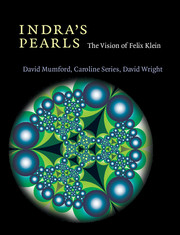Book contents
- Frontmatter
- Contents
- Preface
- Introduction
- 1 The language of symmetry
- 2 A delightful fiction
- 3 Double spirals and Möbius maps
- 4 The Schottky dance pages 96 to 107
- 4 The Schottky dance pages 107 to 120
- 5 Fractal dust and infinite words
- 6 Indra's necklace
- 7 The glowing gasket
- 8 Playing with parameters pages 224 to 244
- 8 Playing with parameters pages 245 to 267
- 9 Accidents will happen pages 268 to 291
- 9 Accidents will happen pages 291 to 296
- 9 Accidents will happen pages 296 to 309
- 10 Between the cracks pages 310 to 320
- 10 Between the cracks pages 320 to 330
- 10 Between the cracks pages 331 to 340
- 10 Between the cracks pages 340 to 345
- 10 Between the cracks pages 345 to 352
- 11 Crossing boundaries pages 353 to 365
- 11 Crossing boundaries 365 to 372
- 12 Epilogue
- Index
- Road map
10 - Between the cracks pages 331 to 340
Published online by Cambridge University Press: 05 January 2014
- Frontmatter
- Contents
- Preface
- Introduction
- 1 The language of symmetry
- 2 A delightful fiction
- 3 Double spirals and Möbius maps
- 4 The Schottky dance pages 96 to 107
- 4 The Schottky dance pages 107 to 120
- 5 Fractal dust and infinite words
- 6 Indra's necklace
- 7 The glowing gasket
- 8 Playing with parameters pages 224 to 244
- 8 Playing with parameters pages 245 to 267
- 9 Accidents will happen pages 268 to 291
- 9 Accidents will happen pages 291 to 296
- 9 Accidents will happen pages 296 to 309
- 10 Between the cracks pages 310 to 320
- 10 Between the cracks pages 320 to 330
- 10 Between the cracks pages 331 to 340
- 10 Between the cracks pages 340 to 345
- 10 Between the cracks pages 345 to 352
- 11 Crossing boundaries pages 353 to 365
- 11 Crossing boundaries 365 to 372
- 12 Epilogue
- Index
- Road map
Summary
Jørgensen's doubly-degenerate group
The example in Figure 10.9 is an approximation to a true sphere-filling limit set discovered by Jorgensen. Jørgensen actually discovered a whole category of groups of Möbius maps whose limit sets were later described by Cannon and Thurston as ‘natural sphere-filling curves’, as if they were suitable for sale in the organic produce section of the grocery. One of the remarkable feature of these groups is that they are still discrete in the sense we discussed on p.239ff., even though their limit sets fill up the whole sphere. When there is no regular set, it is not at all obvious how to tell when a group is discrete, although in fact it is a theorem that any limit of discrete groups is itself discrete. In the case of Jørgensen's groups there are deeper reasons connected with three-dimensional hyperbolic geometry, to be touched on in the final chapter.
One way to understand Jørgensen's doubly-degenerate group is to see it as a limit of double cusp groups, using a form of the sock trick explained in the last section. The idea is that we shall start with the sequence of double cusp groups with cusps 1/0, P/Q which we used to converge to Jørgensen's singly-degenerate group, and use Grandma's party trick explained on p.299 in the last chapter to conjugate these groups into groups where the cusps are of the form p/q, −q/p(where q is quite a bit smaller than Q).
- Type
- Chapter
- Information
- Indra's PearlsThe Vision of Felix Klein, pp. 331 - 340Publisher: Cambridge University PressPrint publication year: 2002

